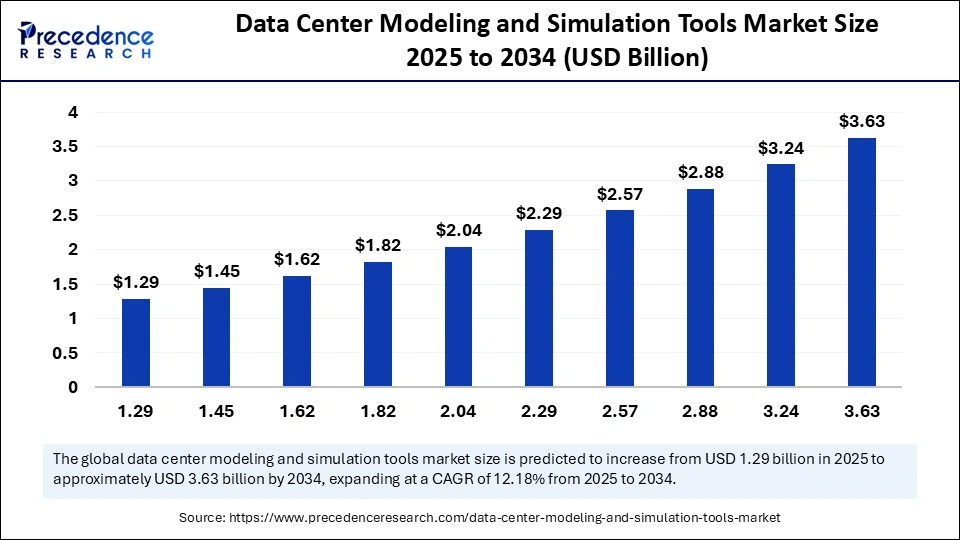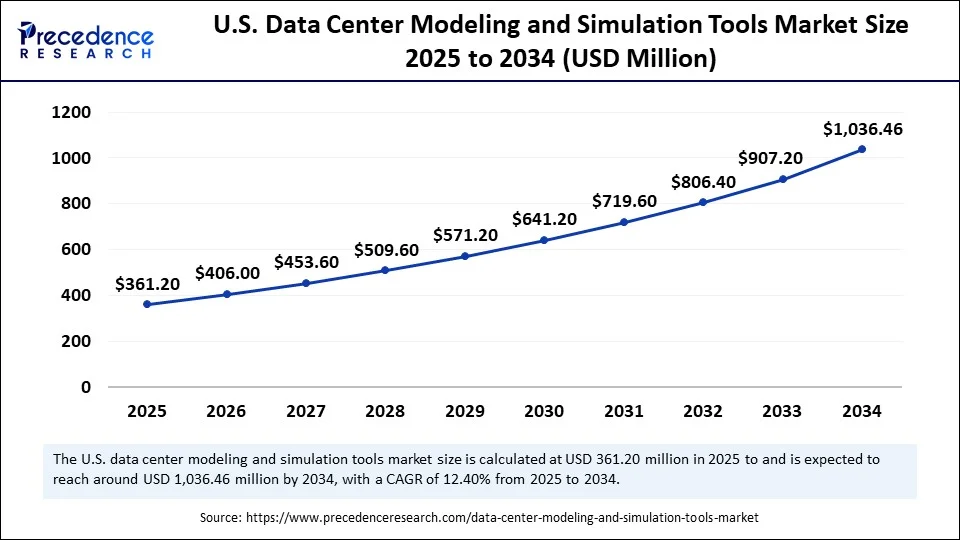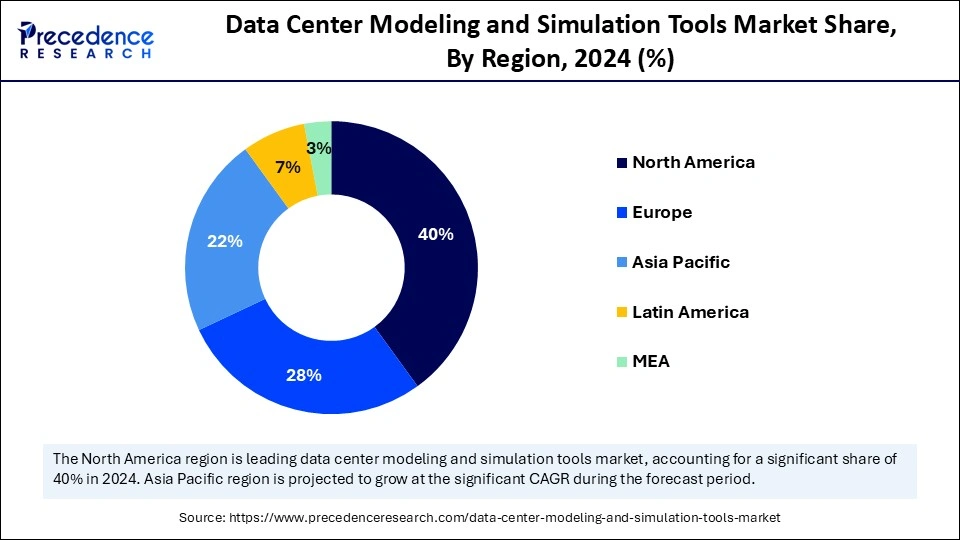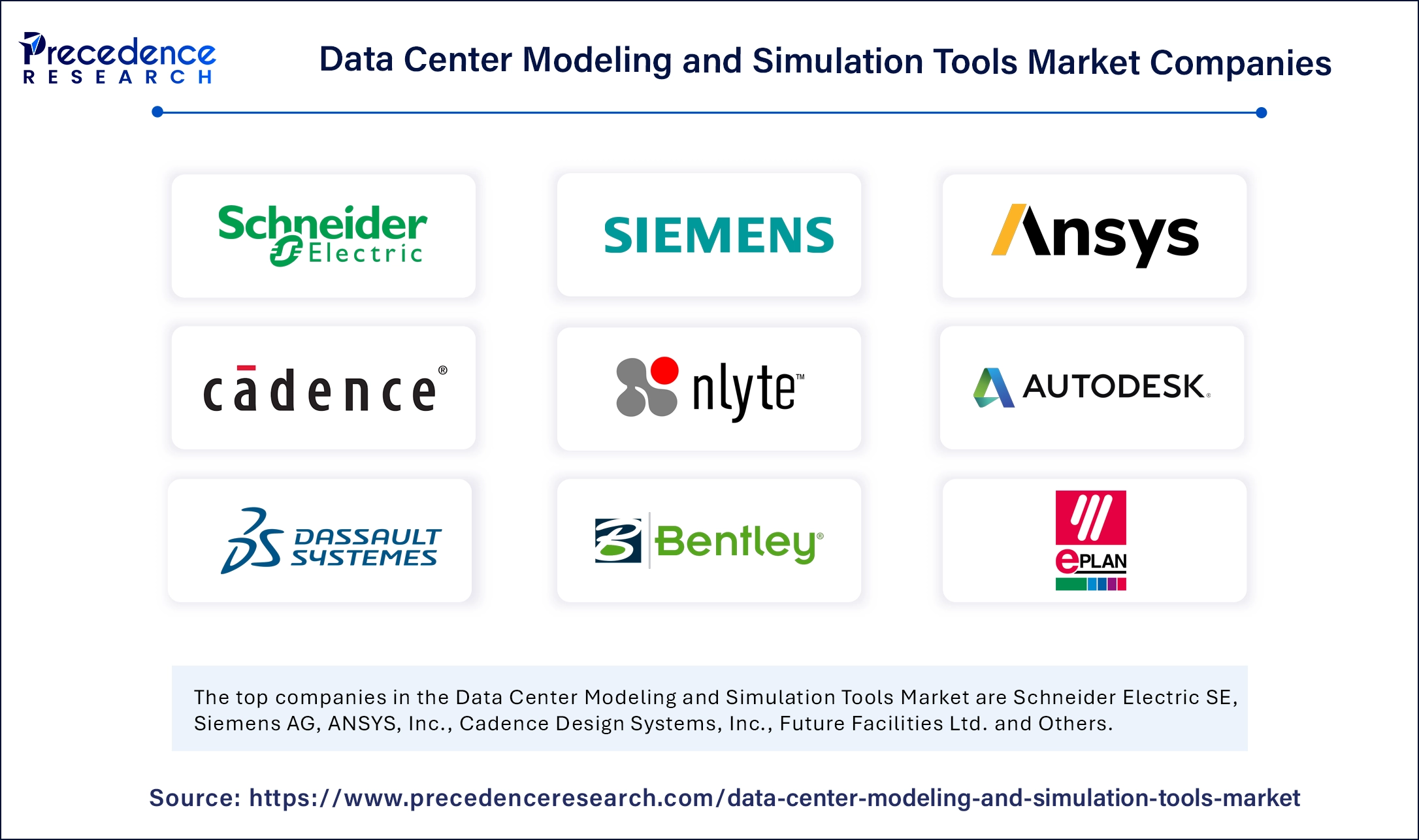List of Contents
Data Center Modeling and Simulation Tools Market Size and Forecast 2025 to 2034
The global data center modeling and simulation tools market size accounted for USD 1.15 billion in 2024 and is predicted to increase from USD 1.29 billion in 2025 to approximately USD 3.63 billion by 2034, expanding at a CAGR of 12.18% from 2025 to 2034. The market is driven by the growing demand for energy-efficient operations, rising complexity of data center infrastructures, and the need for predictive analytics to optimize performance.

Data Center Modeling and Simulation Tools Market Key Takeaways
- In terms of revenue, the global data center modeling and simulation tools market was valued at USD 1.15 billion in 2024.
- It is projected to reach USD 3.63 billion by 2034.
- The market is expected to grow at a CAGR of 12.18% from 2025 to 2034.
- North America dominated the global data center modeling and simulation tools market with the largest market share of over 40% in 2024.
- Asia Pacific is anticipated to witness the fastest growth during the forecasted years.
- By component, the software platforms segment captured the biggest market share of 65% in 2024.
- By component, the services segment is anticipated to show considerable growth over the forecast period.
- By technology, the thermal simulation segment contributed the highest market share of 40% in 2024.
- By technology, the digital twin simulation segment is anticipated to show considerable growth over the forecast period.
- By deployment model, the on-premise segment held the maximum market share of 55% in 2024.
- By deployment model, the cloud-based segment is anticipated to show considerable growth over the forecast period.
- By application, the capacity planning & optimization segment accounted for the significant market share of 35% in 2024.
- By application, the energy efficiency & sustainability segment is anticipated to show considerable growth over the forecast period.
- By end-user, the cloud service providers (CSPs) segment generated the major market share of 40% in 2024.
- By end-user, the enterprises segment is anticipated to show considerable growth over the forecast period.
Market Overview
They are the tools that are used to ensure that the data centers run more efficiently and reliably by modeling such aspects as energy consumption, cooling, airflow control, allocation of power, and the placement of servers. They also find application in workload management in the field of IT, capacity planning, and predictive analysis to help organizations reduce downtime and maximize performance. The greater use of simulation technologies has been triggered by the need to bring more intelligent, data-driven decision-making, where the relevance of hyperscale data centers, edge computing, and cloud-based infrastructure is pivotal.
The increasing data center modeling and simulation tools market pressure to achieve sustainability and minimize carbon footprints is also driving the demand for more sophisticated modeling and simulation solutions. Also, the combination of artificial intelligence and machine learning is transforming the way these platforms offer predictive insights, allowing them to work proactively to maintain high efficiency in operations. With the growing reliance on data-driven operations in businesses, simulation and modeling tools are becoming an imperative source of enabling cost savings, optimization of performance, and long-term reliability in data centers.
How is AI Integration Transforming the Data Center Modeling and Simulation Tools Market?
The data center modeling and simulation tools market is being transformed by AI integration, which allows smarter and data-driven decision-making and predictive operations. Such integration will enable data centers to transition between reactive and proactive management, which will greatly decrease downtime and enhance the efficiency of the entire work. In addition, AI enhances optimization of cooling and power usage by getting to know the usage patterns and suggesting cost-effective modifications without undermining performance. The operators are also able to predict complex situations and determine the most sustainable solutions to minimise carbon footprints by using machine learning algorithms.
What Factors Are Fueling the Rapid Expansion of the Data Center Modeling and Simulation Tools Market?
- Increasing the Data Center Complexity: The emergence of hyperscale and edge data centers has put pressure on operations to such a degree that advanced simulation tools are required. As the infrastructures are scaled, with the modeling tools, one can provide valuable information on the aspect of controlling the scalability of the infrastructures and the control of the IT workloads.
- Greater Energy Costs and Energy Demand Absolutes: With the rise in energy costs and energy sustainability requirements, simulation tools are being adopted to create and streamline energy-efficient cooling, airflow control, and power distribution. These tools contribute to the realization of economic and environmental goals due to the minimization of wastage of energy and the cost of operation.
- Digital Transformation and Sustainability Goals: The simulation tools help enable operators to develop infrastructures that operate within the sustainability objective in terms of carbon footprints, resource wastage, and overall efficiency.
Market Scope
| Report Coverage | Details |
| Market Size by 2034 | USD 3.63 Billion |
| Market Size in 2025 | USD 1.29 Billion |
| Market Size in 2024 | USD 1.15 Billion |
| Market Growth Rate from 2025 to 2034 | CAGR of 12.18% |
| Dominating Region | North America |
| Fastest Growing Region | Asia Pacific |
| Base Year | 2024 |
| Forecast Period | 2025 to 2034 |
| Segments Covered | Component, Technology, Deployment Model, Application, End User, and Region |
| Regions Covered | North America, Europe, Asia-Pacific, Latin America, and Middle East & Africa |
Market Dynamics
Drivers
Complexity and Efficiency Driving Data Center Simulation Tools
The data centers require quality solutions regarding their performance and energy efficiency, as well as cost minimization. As cloud computing, artificial intelligence, Internet of Things, and high-performance computing workloads have increased, operators have to struggle with unparalleled challenges in the regulation of power distribution, cooling systems, airflow, and the allocation of IT resources. The critical benefit of simulation tools is that organizations can build a digital twin of their infrastructure and, therefore, design, test, and predict behavior virtually before implementation. This will reduce risk, operational costs, and increase uptime. Besides, increased attention to sustainability and carbon footprint among the world population is increasing its uptake, as the tools can be used to find energy-saving measures and enhance the use of resources.
Restraint
High Costs and Complexity
The biggest obstacle to the data center modeling and simulation tools market is the initial cost involved in installing sophisticated software licenses, powerful computer hardware, and continued training for operators and engineers. The other difficulty is the complexity of the realistic simulation of data center environments in the real world. Dynamic factors of airflow, power consumption, and heat transfer are characterized by a significant amount of interdependence, and thus, accurate modeling is both time-intensive and technically challenging. Poor expertise or mismanagement of such tools can result in wrong simulation, and the same can influence decision-making.
Opportunity
Sustainability and Digital Transformation
The data center modeling and simulation tools market is experiencing opportunities due to the global shift to sustainability and digital transformation. With concerns on carbon emission and rising electricity prices remaining a top priority, companies have resorted to modeling and simulation packages to identify energy-efficient design solutions. Such platforms enable the operator to make the best use of power allocation, cooling mechanisms, and airflow, which in turn leads to savings in costs and greener activities.
The speed of digitalization in industries has generated pressure to have a resilient and scalable data center. Simulation tools are very important in the design of infrastructures that can support cloud computing, AI, IoT, and edge computing applications. With the continued pressures on energy-efficient and sustainable solutions by governments, enterprises, and consumers, the need for advanced simulation tools will increase exponentially, which will provide enormous growth opportunities.
Component Insights
Why Did the Software Platforms Segment Lead the Data Center Modeling and Simulation Tools Market?
The software platforms segment led the market while holding a 65% share in 2024. The simulation is based on software platforms that give the organizations the power to develop digital twins of their data centers to model, test, and optimize their performance. Such platforms are widely used to model the airflow, power distribution, cooling effectiveness, and IT workload control so that operators can see the inefficiencies before they affect real-life affairs. The increased use of hyperscale and edge data centers, where sophisticated planning and optimization are demanded, has increased the need for powerful simulation software. There is also the use of AI and machine learning on such platforms, which has increased the predictive analytics feature that allows organizations to minimize downtime and maximize sustainability.
The consulting & integration sub-segment of the services segment is anticipated to have the fastest growth. With the adoption of simulation tools by operators, there is a tendency to engage expert services in the implementation, customization, and integration of these tools with the existing data center infrastructure management systems. Consulting services can assist organizations to develop custom solutions that work towards the objective business goals, energy optimization, and operational efficiency. Meanwhile, integration services are important to facilitate interoperability of various vendor tools with the current IT infrastructure.Moreover, the businesses that lack in-house knowledge are very dependent on Third-party vendors in terms of training and support. With the growth of the data centers in scale and complexity, performance by service providers will become more crucial in assisting organisations to obtain the maximum advantage of simulation tools.
Simulation Type Insights
Why Did the Thermal & Power Simulation Segment Capture the Largest Revenue Share?
The thermal simulation segment held around 40% share in the market in 2024. Thermal simulations may allow operators to investigate airflow and heat transfer to ensure that servers and equipment are positioned optimally to eradicate hotspots and maximize cooling performance. Simulation tools on power on the other hand, aid in designing a powerful power delivery system that will prevent failures and maintain continuous uptime. As energy prices increase and organizations focus more on sustainability, these simulations are being used to cut costs, decrease carbon footprints, and maximize the performance of infrastructure by organizations. The increasing complexity of hyperscale and edge data centers further contributes to the significance of thermal and power simulation for efficiency and reliability of operation.
The digital twin simulation segment is expected to grow substantially in the data center modeling and simulation tools market, as a result of the growing demand to enable real-time monitoring, predictive analytics, and upstream data center operations management. Digital twin technology creates a virtual duplicate of the real-life data center, which can be utilized by operators to simulate conditions and test designs, and even to optimize the performance without affecting real-life operations. The approach fosters capacity planning, predictive maintenance and disaster recovery plans by providing the behavior of the infrastructure with a global view. The importance of digital twin simulations is on the rise because businesses are undergoing a rapid digitization process and diversifying their reliance on hyperscale and edge computing.
Deployment Model Insights
Why Did the On-Premise Deployment Segment Lead the Data Center Modeling and Simulation Tools Market?
The on-premise segment led the market, holding around a 55% share in 2024. Enterprises and data center operators prefer on-premise solutions because they need to gain complete control over their infrastructure, data security, and compliance. On-premise deployments offer close access to digital twins, thermal and power modeling, and predictive modeling, and allow fine-tuning of airflow, power allocation, cooling, and workloads. Moreover, it is also beneficial as organizations retain complete control over their confidential operational information and lessen the chances of exposure or breach. Reliability, control, and the ability to manage complex and large-scale simulations also see to it that on-premise solutions still dominate the market.
The cloud-based segment is expected to grow at a significant CAGR over the forecast period. Cloud-based simulation platforms allow businesses to use high-quality data center modeling software at no cost with minimal up-front investment in hardware and software licenses or IT personnel. Cloud environments are more appropriate in small to medium-sized data centres, edge facilities, and organisations undergoing a fast digital transformation. Moreover, it can be implemented on the cloud, which makes remote monitoring and updates constant, and reduces the maintenance work compared to on-premises solutions. Cloud-based data center modelling and simulation tools are rapidly being embraced with the greater adoption of hybrid and edge-based computing strategies by enterprises, as well as being projected to have extraordinary expansion in the market.
Application Insights
Why Did the Capacity Planning & Optimization Segment Hold the Largest Market Share?
The capacity planning & optimization segment led the data center modeling and simulation tools market while holding around 35% share in 2024. The virtualization tools enable the operators to successfully estimate IT workloads, power distribution, cooling requirements, as well as server locality in a manner that the infrastructure is used efficiently without being over-provisioned. Capacity planning can also aid strategic planning of expansions, migrations, and upgrades to enable organizations to make the most efficient investments in hardware and infrastructure. As hyperscale and edge data centers become larger and more complex, accurate capacity planning is becoming a more critical requirement.
The energy efficiency & sustainability segment is expected to grow at a significant CAGR over the forecast period, due to the worldwide trend of seeking cleaner and more sustainable data center operations. Increasing energy prices, environmental policies, and corporate sustainability programs are encouraging organizations to implement modeling and simulation tools that will help in the optimization of power usage and cooling efficiency and the general management of resources. Such tools allow the operators of the data centers to model the patterns of energy consumption, detect inefficiency, and instigate measures that minimize carbon footprints without compromising on operational performance. It can be integrated with AI and predictive analytics to monitor and adaptively control in real-time, which increases energy savings.
End-User Insights
Why Did the Cloud Service Providers Segment Dominate the Data Center Modeling and Simulation Tools Market?
The cloud service providers (CSPs) segment held around 40% share in the market in 2024. The cloud service providers handle hyperscale and distributed data centres at a large scale, which require intense planning, optimization, and predictive services to ensure the services are available. The simulation tools help these providers to design efficient infrastructure in terms of energy saving, server and storage location optimization, managing cooling infrastructure, and forecasting workload needs. Cloud operators will predict probable failures, reduce downtime, and maximize operations efficiency in various data center locations with the assistance of predictive modeling and digital twins. The fast development of cloud computing, the increasing need for high-performance computing, and the emphasis on sustainability make cloud service providers the most active end-users because organizations constantly require tools to keep a complex infrastructure managed effectively with the highest level of reliability and the quality of provided services.
The enterprises segment is expected to grow substantially in the data center modeling and simulation tools market. Enterprise-level programs of digital transformation, cloud rollouts, and AI-based operations rely on the need to have highly optimized and resilient data centers. Simulation tools are used to assist enterprises in modeling workloads, optimizing energy use, and preparing to expand capacity without impacting current operations. These tools will provide a strong infrastructure management in industries such as healthcare and BFSI, where data security, uptime, and compliance are of utmost importance to facilitate predictive maintenance and disaster recovery. The increasing use of edge computing and hybrid IT environments accelerates the necessity even more in modeling solutions to run distributed infrastructure efficiently.
U.S. Data Center Modeling and Simulation Tools Market Size and Growth 2025 to 2034
The U.S. data center modeling and simulation tools market size was exhibited at USD 322.00 million in 2024 and is projected to be worth around USD 1,036.46 million by 2034, growing at a CAGR of 12.40% from 2025 to 2034.

Why Does North America Lead the Data Center Modeling and Simulation Tools Market?
North America led the global market in 2024 because the region boasts of advanced IT infrastructure, the early implementation of digital technologies, and the availability of large cloud and technology providers. The growing sophistication of hyperscale and edge data centers in the region has increased the importance of powerful modeling and simulation tools to maximize power consumption, cooling energy, server location, and overall infrastructure performance. Moreover, the well-established regulatory environment, robust R&D industry, and innovation orientation in the region have enabled the swift integration of new advanced tools in the prevailing data center processes.
The U.S. is a major player in the North American data center modeling and simulation tools market. The U.S. is a centre of innovation in simulation technologies, boasting popular clouds as well as massive investments in hyperscale data centres and global technological leaders. The accelerating focus on energy-efficient and sustainable computing has increased the pace at which AI-based predictive maintenance, workload optimization, and disaster recovery planning modeling tools have been adopted. Adoption of technologies is also a robust culture in the U.S., and the business and service providers can easily inject advanced digital twin and simulation platforms into their workflows.

Why is Asia Pacific Experiencing the Fastest Growth in the Data Center Modeling and Simulation Tools Market?
Asia Pacific is estimated to grow at the fastest CAGR during the forecast period, due to the high rate of digital transformation in the region and increased cloud computing adoption. The increased adoption of hyperscale and edge data centers to deliver applications to AI and IoT, as well as high-performance computing workloads, is exerting a high level of pressure on advanced simulation tools. Faster adoption is also motivated by the necessity to reduce energy consumption and maintainability goals since modeling tools may be deployed to ensure that operations are as cheap and non-carbon-intensive as they can be. In addition, the governments of the region, like India, Japan, or South Korea, are promoting the digital infrastructure and smart cities development, as well as the green computing programs, which also launch the use of these solutions.
China is a key driver of the booming growth of the Asia Pacific data center modeling and simulation tools market as it is investing significantly in cloud services, hyperscale data centres, and AI-based applications. The Chinese enterprises and technology giants are embracing the digital twin and simulation solutions to improve their efficiency in operations and energy management, as well as predictive maintenance. Moreover, the fast rate of digitalization of the Chinese industries, as well as the rise in the number of AI, IoT, and big data applications, has led to the necessity of tools that would guarantee capacity planning, optimization of workflow, and reliability of infrastructure.
Data Center Modeling and Simulation Tools Market Companies

- Schneider Electric SE
- Siemens AG
- ANSYS, Inc.
- Cadence Design Systems, Inc.
- Future Facilities Ltd. (6SigmaDCX)
- Nlyte Software (Carrier Global)
- Autodesk, Inc.
- Dassault Systèmes SE
- Romonet (Schneider Electric)
- Bentley Systems Inc.
- EPLAN Software & Service GmbH
- Huawei Technologies Co., Ltd.
- IBM Corporation
- Microsoft Corporation (Azure Digital Twins)
- Altair Engineering Inc.
- FDT Consulting Engineers & Planners GmbH
- Stulz GmbH
- EkkoSense Ltd.
- T-Systems International GmbH
- Optimum Path Inc.
Recent Developments
- In July 2025, Synopsys (formerly Ansys) announced the 2025 R2 release, with AI-enhanced features that provide faster simulation and increase accessibility to its entire portfolio. There are also new solvers, a more streamlined workflow, better Python support, and on-demand cloud computing to be part of the update to allow engineering to be more agile.(Source: https://www.hpcwire.com)
- In June 2025, IBM and Japan's national research laboratory RIKEN announced the IBM Quantum System Two, the first application of such a system outside the United States and not part of an IBM Quantum Data Center. This milestone is also the first quantum computer that is co-located with the supercomputer Fugaku of RIKEN, which is one of the fastest classical processors in the world. (Source: https://newsroom.ibm.com)
- In June 2025, Cisco, with NVIDIA, announced innovations to expedite the use of AI in data centers. Those solutions are centered around high-performance, low-latency networking to fulfill the increasing needs of AI workloads and provide secure and scalable infrastructure.(Source: https://analyticsindiamag.com)
Segment Covered in the Report
By Component
- Software Platforms
- Services
- Consulting & Advisory Services
- Integration & Deployment Services
- Support & Maintenance Services
By Technology
- Thermal Simulation (Cooling & Airflow Management)
- Power & Energy Simulation
- Network Simulation
- Computational Fluid Dynamics (CFD) Modeling
- IT Workload & Performance Simulation
- Digital Twin Simulation (Holistic Data Center Modeling)
By Deployment Model
- On-Premise
- Cloud-Based
- Hybrid
By Application
- Capacity Planning & Optimization
- Energy Efficiency & Sustainability
- Risk Assessment & Disaster Recovery Planning
- Real-Time Monitoring & Performance Management
- Design & Construction (Greenfield & Retrofit Projects)
- Compliance & Regulatory Management
By End User
- Cloud Service Providers (CSPs)
- Colocation Providers
- Enterprises (Banking, Retail, Telecom, Healthcare, etc.)
- Government & Defense Organizations
- Research & Academic Institutions
By Region
- North America
- Europe
- Asia-Pacific
- Latin America
- Middle East & Africa
For inquiries regarding discounts, bulk purchases, or customization requests, please contact us at sales@precedenceresearch.com
Frequently Asked Questions
Ask For Sample
No cookie-cutter, only authentic analysis – take the 1st step to become a Precedence Research client